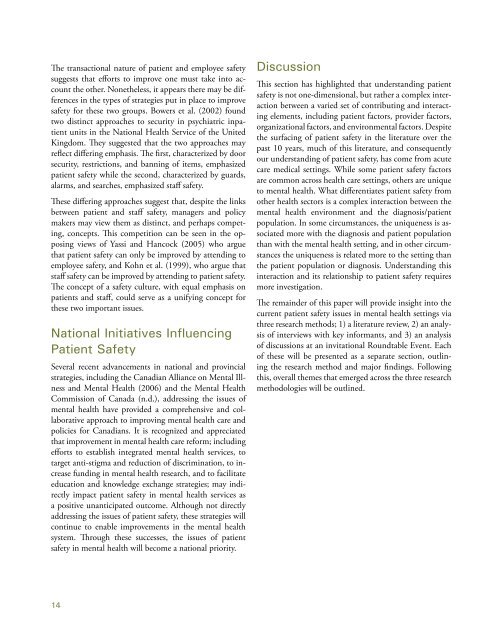Patient safety in mental health - Canadian Patient Safety Institute ...
Patient safety in mental health - Canadian Patient Safety Institute ...
Patient safety in mental health - Canadian Patient Safety Institute ...
Create successful ePaper yourself
Turn your PDF publications into a flip-book with our unique Google optimized e-Paper software.
The transactional nature of patient and employee <strong>safety</strong><br />
suggests that efforts to improve one must take <strong>in</strong>to account<br />
the other. Nonetheless, it appears there may be differences<br />
<strong>in</strong> the types of strategies put <strong>in</strong> place to improve<br />
<strong>safety</strong> for these two groups. Bowers et al. (2002) found<br />
two dist<strong>in</strong>ct approaches to security <strong>in</strong> psychiatric <strong>in</strong>patient<br />
units <strong>in</strong> the National Health Service of the United<br />
K<strong>in</strong>gdom. They suggested that the two approaches may<br />
reflect differ<strong>in</strong>g emphasis. The first, characterized by door<br />
security, restrictions, and bann<strong>in</strong>g of items, emphasized<br />
patient <strong>safety</strong> while the second, characterized by guards,<br />
alarms, and searches, emphasized staff <strong>safety</strong>.<br />
These differ<strong>in</strong>g approaches suggest that, despite the l<strong>in</strong>ks<br />
between patient and staff <strong>safety</strong>, managers and policy<br />
makers may view them as dist<strong>in</strong>ct, and perhaps compet<strong>in</strong>g,<br />
concepts. This competition can be seen <strong>in</strong> the oppos<strong>in</strong>g<br />
views of Yassi and Hancock (2005) who argue<br />
that patient <strong>safety</strong> can only be improved by attend<strong>in</strong>g to<br />
employee <strong>safety</strong>, and Kohn et al. (1999), who argue that<br />
staff <strong>safety</strong> can be improved by attend<strong>in</strong>g to patient <strong>safety</strong>.<br />
The concept of a <strong>safety</strong> culture, with equal emphasis on<br />
patients and staff, could serve as a unify<strong>in</strong>g concept for<br />
these two important issues.<br />
National Initiatives Influenc<strong>in</strong>g<br />
<strong>Patient</strong> <strong>Safety</strong><br />
Several recent advancements <strong>in</strong> national and prov<strong>in</strong>cial<br />
strategies, <strong>in</strong>clud<strong>in</strong>g the <strong>Canadian</strong> Alliance on Mental Illness<br />
and Mental Health (2006) and the Mental Health<br />
Commission of Canada (n.d.), address<strong>in</strong>g the issues of<br />
<strong>mental</strong> <strong>health</strong> have provided a comprehensive and collaborative<br />
approach to improv<strong>in</strong>g <strong>mental</strong> <strong>health</strong> care and<br />
policies for <strong>Canadian</strong>s. It is recognized and appreciated<br />
that improvement <strong>in</strong> <strong>mental</strong> <strong>health</strong> care reform; <strong>in</strong>clud<strong>in</strong>g<br />
efforts to establish <strong>in</strong>tegrated <strong>mental</strong> <strong>health</strong> services, to<br />
target anti-stigma and reduction of discrim<strong>in</strong>ation, to <strong>in</strong>crease<br />
fund<strong>in</strong>g <strong>in</strong> <strong>mental</strong> <strong>health</strong> research, and to facilitate<br />
education and knowledge exchange strategies; may <strong>in</strong>directly<br />
impact patient <strong>safety</strong> <strong>in</strong> <strong>mental</strong> <strong>health</strong> services as<br />
a positive unanticipated outcome. Although not directly<br />
address<strong>in</strong>g the issues of patient <strong>safety</strong>, these strategies will<br />
cont<strong>in</strong>ue to enable improvements <strong>in</strong> the <strong>mental</strong> <strong>health</strong><br />
system. Through these successes, the issues of patient<br />
<strong>safety</strong> <strong>in</strong> <strong>mental</strong> <strong>health</strong> will become a national priority.<br />
1<br />
Discussion<br />
This section has highlighted that understand<strong>in</strong>g patient<br />
<strong>safety</strong> is not one-dimensional, but rather a complex <strong>in</strong>teraction<br />
between a varied set of contribut<strong>in</strong>g and <strong>in</strong>teract<strong>in</strong>g<br />
elements, <strong>in</strong>clud<strong>in</strong>g patient factors, provider factors,<br />
organizational factors, and environ<strong>mental</strong> factors. Despite<br />
the surfac<strong>in</strong>g of patient <strong>safety</strong> <strong>in</strong> the literature over the<br />
past 10 years, much of this literature, and consequently<br />
our understand<strong>in</strong>g of patient <strong>safety</strong>, has come from acute<br />
care medical sett<strong>in</strong>gs. While some patient <strong>safety</strong> factors<br />
are common across <strong>health</strong> care sett<strong>in</strong>gs, others are unique<br />
to <strong>mental</strong> <strong>health</strong>. What differentiates patient <strong>safety</strong> from<br />
other <strong>health</strong> sectors is a complex <strong>in</strong>teraction between the<br />
<strong>mental</strong> <strong>health</strong> environment and the diagnosis/patient<br />
population. In some circumstances, the uniqueness is associated<br />
more with the diagnosis and patient population<br />
than with the <strong>mental</strong> <strong>health</strong> sett<strong>in</strong>g, and <strong>in</strong> other circumstances<br />
the uniqueness is related more to the sett<strong>in</strong>g than<br />
the patient population or diagnosis. Understand<strong>in</strong>g this<br />
<strong>in</strong>teraction and its relationship to patient <strong>safety</strong> requires<br />
more <strong>in</strong>vestigation.<br />
The rema<strong>in</strong>der of this paper will provide <strong>in</strong>sight <strong>in</strong>to the<br />
current patient <strong>safety</strong> issues <strong>in</strong> <strong>mental</strong> <strong>health</strong> sett<strong>in</strong>gs via<br />
three research methods; 1) a literature review, 2) an analysis<br />
of <strong>in</strong>terviews with key <strong>in</strong>formants, and 3) an analysis<br />
of discussions at an <strong>in</strong>vitational Roundtable Event. Each<br />
of these will be presented as a separate section, outl<strong>in</strong><strong>in</strong>g<br />
the research method and major f<strong>in</strong>d<strong>in</strong>gs. Follow<strong>in</strong>g<br />
this, overall themes that emerged across the three research<br />
methodologies will be outl<strong>in</strong>ed.


